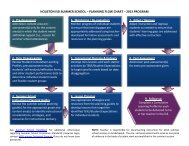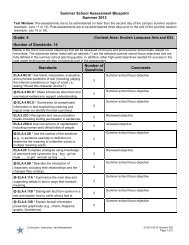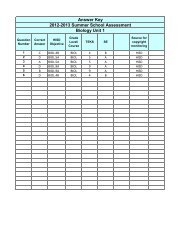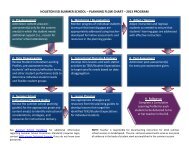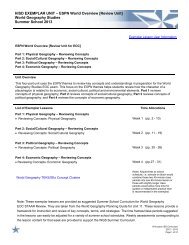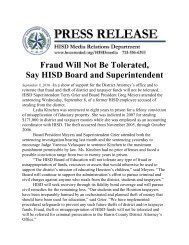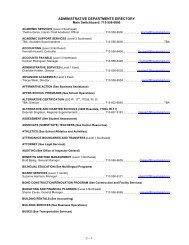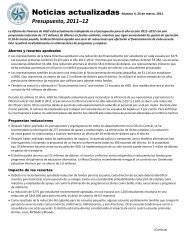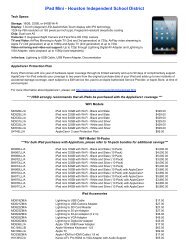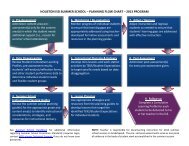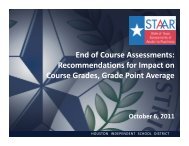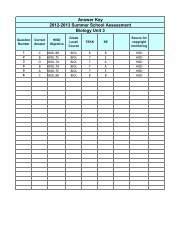SSK Unit 4.2 Planning Guide
SSK Unit 4.2 Planning Guide
SSK Unit 4.2 Planning Guide
- No tags were found...
Create successful ePaper yourself
Turn your PDF publications into a flip-book with our unique Google optimized e-Paper software.
how well questions of purpose, audience, and genre have been addressed.HISD PLANNING GUIDEEnglish Language Arts Grade 7SUMMER SCHOOLS ELA.7.19A.viii identify, use, and understand the function of transitions for sentence to sentence, paragraph toparagraph coherence in the context of reading, writing, and speaking.S ELA.7.19B Write complex sentences and differentiate between main versus subordinate clauses.R ELA.7.19C Identify, use and understand the function of a variety of complete sentences (e.g., simple, compound,complex) that include properly placed modifiers, correctly identified antecedents, parallel structures, and consistenttenses.R ELA.7.14D Edit drafts for grammar, mechanics, and spelling.R ELA.7.20A Use conventions of capitalization correctly and consistently.R ELA.7.20B.i Recognize and use punctuation marks including commas in compound sentences and after introductorywords, phrases, and clauses.R ELA.7.21A Spell correctly, including using various resources to determine and check correct spellings. English Language Proficiency Standards (ELPS)• ELPS C.1e Internalize new basic and academic language by using and reusing it in meaningful ways in speaking andwriting activities that build concept and language attainment;• ELPS C.2i Demonstrate listening comprehension of increasingly complex spoken English by following directions,retelling or summarizing spoken messages, responding to questions and requests, collaborating with peers, andtaking notes commensurate with content and grade-level needs;• ELPS C.4g Demonstrate comprehension of increasingly complex English by participating in shared reading, retellingor summarizing material, responding to questions, and taking notes commensurate with content area and grade levelneeds.College and Career Readiness Standards (CCRS)• CCRS 1.A4 Recognize the importance of revision as the key to effective writing. Each draft should refine key ideasand organize them more logically and fluidly, use language more precisely and effectively, and draw the reader to theauthor’s purpose.• CCRS 1.A5 Edit writing for proper voice, tense, and syntax, assuring that it conforms to standard English, whenappropriate.• CCRS 2.A4 Draw and support complex inferences from text to summarize, draw conclusions, and distinguish factsfrom simple assertions and opinions.Key Concepts• genre– informational nonfiction(expository texts)Academic Vocabulary• affixes• graphical components• paraphraseEssential Understandings/Guiding Questions• reading process• graphical components• inference• organizational pattern• subordinate conjunction - English Language Proficiency Standards (ELPS) - Literacy Leads the Way Best Practices - Aligned to Upcoming State Readiness Standard- State Process Standard R - State Readiness Standard S - State Supporting Standard• stylistic elements• text features• summary• text features• thesis• Word roots and affixes provide the foundation to discover the meaning of unfamiliar words1. What is the difference between a prefix and a suffix?2. How do affixes affect the meaning of a word?3. Why is it important to understand the root of a word?• Discovering the organizational pattern of an expository text assists readers in locating and understanding specificinformation within the text.1. What are the various organizational patterns?2. How do organizational patterns affect the information in a text?4. How does knowing the organizational pattern of a text help a reader?• Expository writing is structured through the use of an organizational pattern with a thesis statement and supporting© Houston ISD Curriculum2012 – 2013Page 2 of 12




